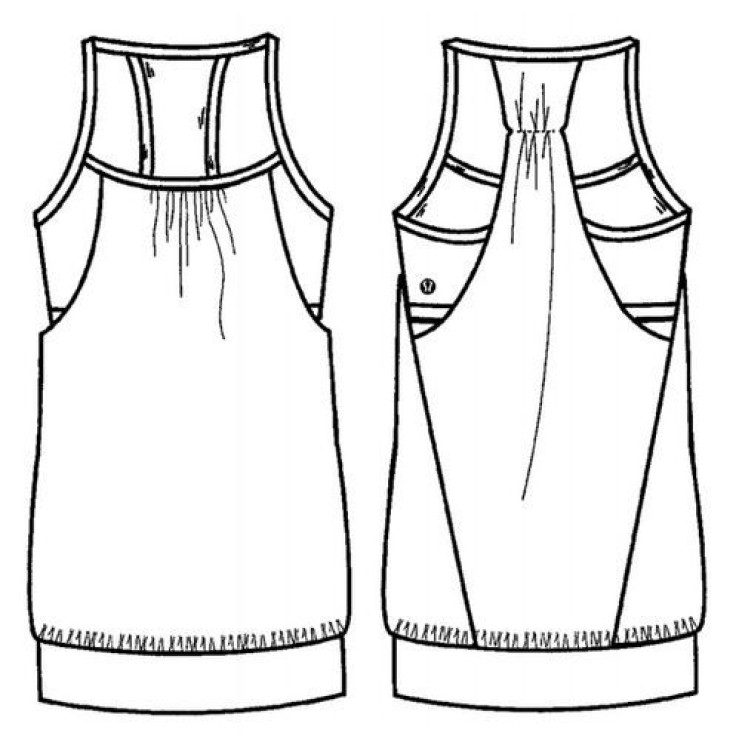Lululemon Tries To Dominate Sports Fashion Industry With Patents On Bras, Tank Tops, And Shorts

Lululemon has aggressively taken on the fashion industry in a way no other brand has: by patenting its clothing designs and suing alleged copycats in the sportswear industry, including Hanesbrands, Calvin Klein, and G-III Apparel. The company already patented 31 of its athletic clothing and workout gear designs and then used those patents to file lawsuits against competitors.
“We’re in a situation where we are not yet sure how valuable design patents are in general, and we’re really not sure how valuable they are for clothing, and Lululemon is becoming the test case,” Susan Scafidi, academic director of the Fashion Law Institute at Fordham University told BuzzFeed. The company has patented everything from bras to duffle bags, according to the U.S. Patent Office’s website. It is uncommon for companies in the fashion industry to seek design patents and then take it to the next level and sue competitors in order to deflect sharing profits from consumers’ allotted spending money.
This is arguably the onset of a monopoly, in which companies take over the sale of one particular item and rule the market. “It’s embarrassing for the Patent Office if they start issuing patents in this area and the courts start overturning them on a regular basis,” Scafidi said. Lululemon reached a confidential settlement with Calvin Klein and G-III over its $98 “Astro Pants” design, but when it sent Hanesbrand a cease-and-desist letter, Hanesbrand turned the tables and filed suit against Lululemon. It objected to the claim and argued the design patent shouldn’t have been issued to begin with because it was an obvious design based on vague drawings, which calls into question the efficacy of the Patent Office. Michael Gilman, Lululemon's lawyer, said Hanesbrands also copied its tanktops, which it sold under the Champion label at Target, copied elements of the Lululemon's design patent.
The workout tanks feature a top with a loose, outer tank over a revealing built-in bra with a tight waitband bottom. Lululemon gave Hanesbrand 15 days to stop production and the brand acquiesced by releasing a press release with Lululemon, stating it would no longer produce the tanktops, but if customers were still interested in the style, they could purchase it at Lululemon. If Hanesbrand didn't give in, there was a possibility of having to undergo legal proceedings in both the United States and Canada, where the company was first founded.

But what does all this legal rhetoric have to do with the consumer? Consumers decide how much market share a company has in a particular industry, such as the athletic apparel industry. The total purchases a customer makes of a product or service, give the company a percentage of its wallet. For example, if consumers as a whole buy 10 billion running shorts and five billion are the Lululemon brand, Lululemon holds 50 percent of the running share market share. Lululemon has just patented 31 of its athletic clothing and gear, which means its company controls the market for people who want sports bras built into baggy shirts, an adjustable yoga workout loop device, or hoods with a hole for ponytails. It’s a classic form of horizontal integration, which is a strategy companies implement in the early stages of building an industry monopolization. It works by acquiring production units for similar outputs, such as its patented clothing in order to decrease competition and increase its market share.
If any competitors make clothing or gear in similar fashion, Lululemon will sue the pants right out of its clothing line, forcibly making its brand the only choice for consumers, also known as monopolizing the industry. Is this fair to the consumer, considering its least expensive sports bra is $42 and its cheapest yoga pants are $82? No one is forcing the consumer to purchase the jacket with the hoody hole, but consumers with tighter budgets have no choice to move to less expensive brands, while Lululemon stands behind its lawyers suing every brand with designs that look remotely like its patents.
“If the design is unique enough, I think the Patent Office should give out patents on it — but how they determine what’s unique enough, that’s the question,” Mark Sunderland, a textile engineer and director of academic operations at Philadelphia University’s School of Design and Engineering, told BuzzFeed. Lululemon has been in the news before for its shortcomings, when it had to recall 17 percent of its pants inventory due to sheer fabric that was too see-through. However, the company’s profits didn’t plummet by a loss of $67 million until the company’s CEO Chip
Wilson said the pants weren’t made for every woman’s body and that it was their thighs' fault for rubbing against and wearing down the material. This may be an attempt to increase value in the brand and raise profit by forcing consumers into a hole. Scafidi asked the U.S. Patent Office if it hires fashion designers or people who have an expertise in fashion in order to effectively make decisions on the filed patents. The Office said no, which may change, considering the warable-technology industry is growing and other brands may apply for patents to follow Lululemon’s bold move.
“They have decided to experiment and throw some resources behind trying to answer that question, so I think a lot of companies are watching Lululemon to see how successful they are or aren’t,” Scafidi said. “With Apple and Samsung, Apple’s patents are doing that for design patents across different creative fields, but Lululemon is doing it specifically for fashion.”



























